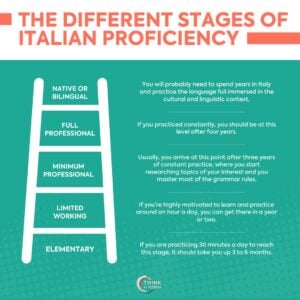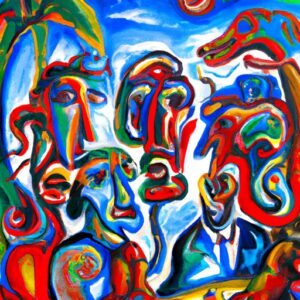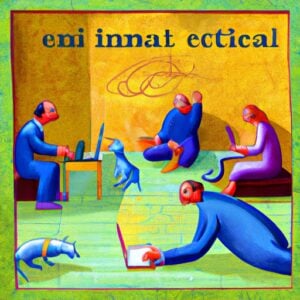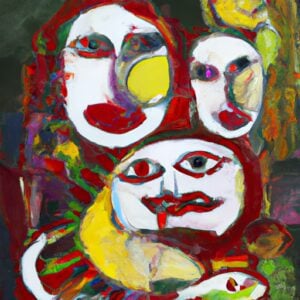Discover the Fascinating Italian Alphabet!
Ready to explore the enchanting Italian language? Discover the Italian alphabet swiftly and effortlessly with our free lesson. In just a few minutes, you’ll gain the foundation you need to pronounce Italian words with confidence.
Gain instant access to our free Italian alphabet lesson by submitting the form below. Start your Italian journey today!
Create a free lifetime account to get access to all the free lesson and other resources.
The basics of the Italian alphabet
The Italian alphabet is a Latin-based alphabet and it consists of:
- 5 vowels A – E – I – O – U
- 16 Italian consonants B – C – D – F – G – H – L – M – N – P – Q – R – S – T – V – Z
- 5 foreign consonants J – K – W – X – Y – Z
All of these letters are shared by the English alphabet, but their Italian pronunciation is not the same!
How to pronounce the Italian alphabet?
- A A / Aah (as in “father”, just more open)
- B Bi / Bee
- C Ci / Chee
- D Di Dee
- E E / Eh (as in “end”, a bit closer)
- F Effe / Eh-ffeh
- G Gi / Gee (as in “jeep”)
- H Acca / Ah-kka (silent)
- I I / Ee
- L Elle / Eh-lleh
- M Emme / Eh-mmeh
- N Enne / Eh-nneh
- O O / Oh (wide “o” as in “front”)
- P Pi / Pee
- Q Qu / Koo
- R Erre / Eh-rreh
- S Esse / Eh-sseh
- T Ti / Tea
- U U / Oo
- V Vi, Vu / Vee, Voo
- Z Zeta / Tseh-tah
As we mentioned earlier, the official Italian alphabet does not include J, K, W, X, and Y, but they still appear in foreign words acquired by the Italian language.
However, these letters are not pronounced in the same way either! Have a look:
- J I lunga / Ee loon-gah (“long i”)
- K Kappa / Kah-ppah
- W Doppia vi, doppia vu / Doh-ppee-ah vee, voo (“double v”)
- X Ics / Eeks
- Y Ipsilon, I greca / Eeps-ee-loh-n, Ee greh-kah (“Greek i”)
Below is a table of the complete Italian alphabet, L’alfabeto Italiano
The Italian alphabet song
What is one of the firsts song you ever learned?
Don’t worry if you don’t remember because I think I have the answer… is The alphabet song!
It might not be the coolest song ever, but it sure is catchy! I still find myself singing it sometimes (especially while writing about the Italian alphabet!).
I can guarantee you will have this tune stuck in your mind for days… Which isn’t bad at all when you are learning the Italian alphabet.
This Italian alphabet song includes the pronunciation of the 5 foreign consonants.
What are the Italian alphabet accents?
As you probably noticed in writing, certain letters could have accent marks on them. In Italian, we can place an accent mark on all five vowels (a, e, i, o, u).
An accent mark, however, does not really change the pronunciation of the vowel, but it denotes the stress pattern in a word.
For example, a grave accent on the letter è makes its pronunciation more open, while an acute accent é only changes the stress of the word.
Another example is the word città (city) which has an accent on the “à” to show that the stress is on the last syllable instead of the second-to-last syllable, which is the normal Italian stress pattern.
The letter Acca (H)
While Italian pronunciation is pretty consistent, some consonants have a particular behavior depending on the case. The consonant H is one of them!
H Before a vowel
As we know, the letter H is called acca and it is silent. When it appears in front of a vowel, we skip it altogether and start the pronunciation with the following letter as in hanno (they have).
H With C and G
When there is an H after C and G, however, things get interesting. As you probably noticed, the consonants C and G have hard and soft pronunciations.
C and G are pronounced like a hard /k/ sound as in “cat” (for C) and /g/ sound, as in “golf,” (for G) when they are followed by the vowels A, O, and U, and by consonants.
For example, casa – house, crescere – to grow, gatto – cat, grattare – to scratch.
Otherwise, C and G are pronounced softly, like a /ch/ sound and a /j/ sound when they are followed by the vowels I and E, like in cielo – sky or gemma – gem.
What do we do, then, to have a hard /k/ or /g/ sound with the vowels I and E? Simple, we put an H in between! So we find that CHI, CHE, GHI, GHE retain the hard sound.
However, “G” is pronounced softly like a /j/ sound, as in “judge,” when it’s followed by the vowels “I” and “E.”
We hear this pronunciation in words like chiesa – church and ghepardo – cheetah.

Italian alphabet with Italian cities
Now that you’ve learned the alphabet let’s practice it a bit with the names of some Italian cities.
Try reading them out loud to practice your pronunciation!
- Ancona
- Bologna
- Cagliari
- Domodossola
- Enna
- Firenze
- Genova
- Hotel
- Isernia
- Livorno
- Milano
- Napoli
- Ostuni
- Palermo
- Quarto
- Roma (the capital of Italy!)
- Sassari
- Torino
- Urbino
- Venezia
- Zagarolo
As foreign letters are only used in foreign words, obviously, they do not appear in the name of Italian cities!
Here are some foreign words adopted by the Italian vocabulary:
- Jeans
- Ketchup
- Wurstel
- Xbox
- Yogurt
Keep in mind this list as it will come in handy when you want to spell a word to someone!



















